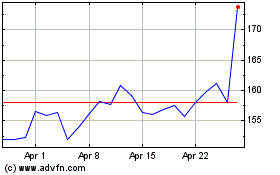Big Tech Earnings Expected to Drive S&P 500 This Week
April 24 2022 - 5:04PM
Finscreener.org
The equity markets have traded in
the red for three consecutive weeks after they rebounded in March.
In the last week ended on April 22, the S&P 500 lost 2.5%
while the Nasdaq Composite and Dow Jones indices were down by 3.6%
and 1.74% respectively.
Investors can expect stocks to
remain volatile in the upcoming week as they wrestle with inflation
and a string of earnings reports. In addition to the ongoing war
between Ukraine and Russia, stocks
have been hurt by concerns
over an economic
slowdown, steep valuations, rising commodity prices, and interest
rate hikes, all of which are likely to result in compressed
earnings for corporates in 2022.
All eyes on big tech earnings
Several tech giants such
as Microsoft (NASDAQ:
MSFT),
Apple (NASDAQ: AAPL), Meta (NASDAQ:
FB),
Amazon (NASDAQ:
AMZN), and Alphabet
(NASDAQ: GOOG)(NASDAQ: GOOGL) are
scheduled to report quarterly results for March this week. Until
now, companies part of the S&P 500 have delivered stellar
results and have outpaced Wall Street estimates in Q1.
However,
shares of streaming giant
Netflix (NASDAQ: NFLX)
were down 35% in a single trading session as the company confirmed
it lost 200,000 subscribers in Q1.
As big tech reports results for
the quarter ended in March, market participants will be watching
closely to gauge the impact of economic pressures that will hurt
subscription-related businesses part of the software and
cybersecurity businesses.
In the past decade, shares of
subscription-based tech stocks were on an absolute tear on the back
of a widening customer base. However, when a company valued at a
premium, experiences moderation in user growth, its underlying
stock is likely to trail the broader market by a wide
margin.
Inflation will be under the spotlight
Wall Street will continue to
consider the impact of inflation and rising costs as data for the
personal consumer expenditure or PCE index will be released on
Friday. The
core PCE which is also the preferred measure of inflation
by the Federal Reserve rose by 5.4% in February.
Here, the PCE excludes food and
energy prices that are volatile but have gained significant
momentum in the last 12-months, resulting in a subdued consumer
spending environment.
According to Steven Major, the
global head of fixed-income research at HSBC, “The surge in
inflation would not be a problem if it was entirely generated by
supply constraints, related to food and energy, but central banks
cannot just sit back and wait for it to normalise.”
Wall Street has priced an
aggressive outlook by the Federal Reserve in 2022. There is a
chance for the Central Bank to raise interest rates by a cumulative
125 basis points by June. Jerome Powell, the chairman of the Fed
explained the regulatory body cannot be complacent even though data
suggests inflation may have peaked as itU+02019s critical to
achieve price stability over time.
Further, in a client note
accessed by CNBC, Ethan Harris, who is the global economist at Bank
of America stated, “In our view, given the dovishness of this
group, the Fed will only deliberately risk a recession if inflation
gets stuck above 3%. Hence, rather than wait with baited breath for
the next Fed speaker, we are focused on one question: is the
economy on a path toward acceptable or unacceptable inflation. All
the rest is talk.”
In addition to the PCE, data for
the S&P/Case-Shiller home price index as well as new home
sales will be released on Tuesday. It will be supplemented by the
earnings of D.R. Horton (NYSE: DHI)
which will provide investors with a comprehensive view of the
housing market in the U.S.
Finally, preliminary data for the
GDP in Q1 will be published on Thursday and will give you a hint of
an impending economic slowdown.
Alphabet (NASDAQ:GOOG)
Historical Stock Chart
From Mar 2024 to Apr 2024

Alphabet (NASDAQ:GOOG)
Historical Stock Chart
From Apr 2023 to Apr 2024
